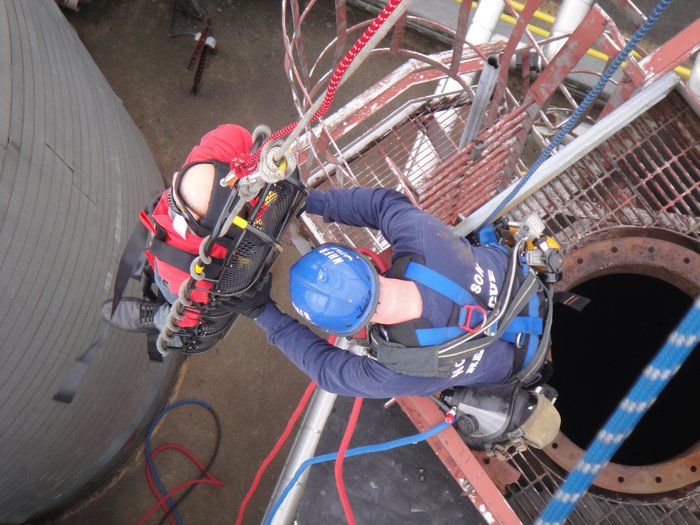In fire and rescue lingo, “confined space” means an area that usually has only one entry and is not meant for human occupancy, such as tunnels, shafts, construction sites and silos, hazardous or toxic environments with a lack of oxygen. According to Battalion Chief Mike Falco of the North Hudson Regional Fire and Rescue (NHRFR), confined space incidents account for a high mortality rate across the country.
To prepare to deal with such incidents, the NHRFR called on its long-standing relationship with the chemical plant facilities at WR Grace & Co. at 85th Street and Tonnelle Avenue for confined space and high angle rescue training on Oct. 15 through 18.
“Our department addresses this issue through proper training and planning,” said Chief Falco. “[It’s a] great experience for the firefighters, because it’s a real simulated drill.”
Falco said that training for his team is “essential” for their future rescues.
Grace Industries is well aware that they may need to call upon the North Hudson Regional Fire and Rescue, so allowing them to train in their facility is a plus for the company.
“Grace Industries provides us with a training site that is as realistic as it gets.” – Battalion Chief Mike Falco
____________
“Grace Industries provides us with a training site that is as realistic as it gets,” said Falco. “We train as if it’s the real deal.”
The North Hudson Regional Fire and Rescue serves residents from North Bergen, Union City, Weehawken, West New York and Guttenberg.
Grace has several dozen storage tanks which allow the NHRFR a wide array of opportunities that vary each time they go for training.
Troyano, who has worked for Grace for 13 years, and Chief Falco, who has worked with NHRFR for nearly 30 years, have been working together for years in order to strengthen the NHRFR.
Grace Industries has long been a supporter of the NHRFR and has donated up to almost $50,000 over the years. The donations have been used to buy supplemental rescue equipment for NHRFR. Grace had a three year grant with the NHRFR which has reduced due to the instability of the economy said Troyano.
Troyano announced to the NHRFR that Grace would contribute $12,000 for the next three years.
“The reason we have done it is community relations,” said Troyano. “There’s a big push with our company to have the exposure in the community, working with the school, working with the fire department… It’s being here and letting the community know that we’re a presence and that we can help if there’s anything that’s needed.”
Safety drill
The drill was planned during the summer. A dummy that weighed 110 pounds was put at the bottom of a storage unit to be hoisted up by the team, simulating the rescue of an unconscious person.
Prior to the rescue, the team huddled together to review safety precautions, including establishing a rally point where they would meet in case of an injury on the team. Falco and Troyano filled out the mandatory confined space checklist.
Before getting started, the ropes and air supply used by the rescuers were secured. The rescuers each carried both air supply and auxiliary tanks in case one failed.
Every shift of the NHRFR was trained for high angle confined space from Oct. 15 to 18. It was a team effort, as each group was in charge of entry, the lowering operation or ventilation which would monitor the air every four feet. There were roughly 18 firefighters that would be a part of every drill. A fire truck with an aerial ladder was used for the drill and was extended to 90 feet.
A three year clean storage tank was used for training.
“They partnered with us out of generosity to support the department,” said Falco.
Vanessa Cruz can be reached at vcruz@hudsonreporter.com
